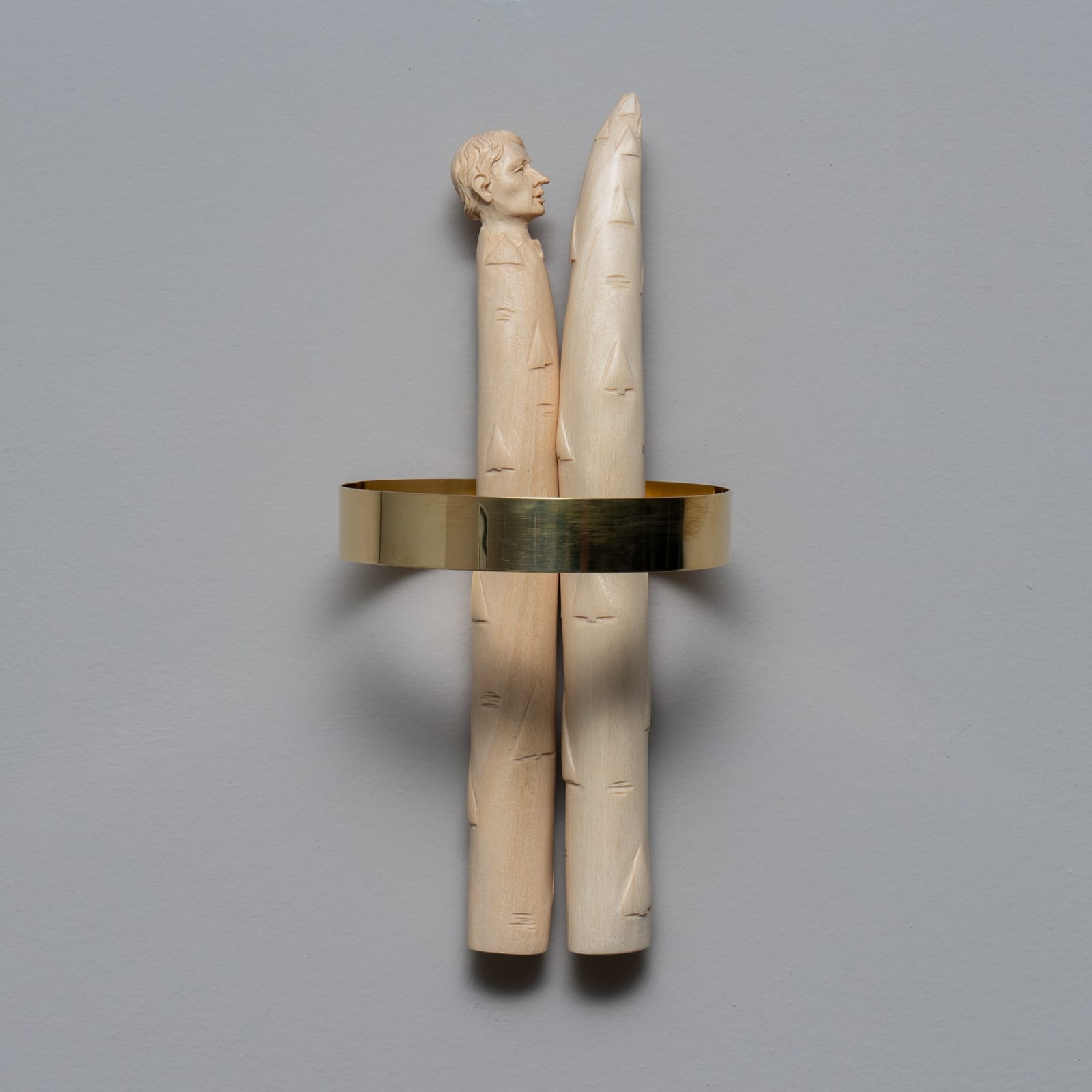Young-jun Tak 卓永俊
My Projection 我的投射, 2024
lime wood, brass, beeswax 椴木、黄铜、蜂蜡
25.3 x 11 x 10.8 cm
10 x 4 1/2 x 4 1/2 in
10 x 4 1/2 x 4 1/2 in
Edition of 5 plus 1 artist's proof
'My Projection” (2024) is a sculptural work by Young-jun Tak. Hand-carved from lime wood by a Bavarian family of master woodcarvers in their 15th generation of sculpting religious figures, the...
"My Projection” (2024) is a sculptural work by Young-jun Tak.
Hand-carved from lime wood by a Bavarian family of master woodcarvers in their 15th generation of sculpting religious figures, the piece features two white asparagus stalks encircled by a polished brass ring. Notably, a young male head emerges from one stalk, gazing upward with an expression of longing. When viewed from a specific angle, the composition reveals a Latin cross shape. This work explores themes of desire, cultural symbolism, and the intersection of the sacred and the everyday.
White asparagus, known as Spargel, is one of the most beloved vegetables in German-speaking regions. Originally introduced to Europe from Asia, the Middle East, and North Africa, it was brought to the territories of present-day Germany through ancient Roman culinary traditions. Revered as “white gold,” it is traditionally harvested each spring from April until June 24th—the feast day of Saint John the Baptist, which coincides with the ancient Northern European summer solstice. According to biblical accounts, John the Baptist was beheaded by order of Herod Antipas at the request of his stepdaughter, Salome. The human head in the sculpture is based on historical depictions of the saint, drawing a symbolic connection between the revered vegetable and the martyr’s fate.
Young-jun Tak (b. 1989, Seoul) in his sculptures and films examines the socio-cultural and psychological mechanisms that shape belief systems, ranging from simple objects of worship to sophisticated forms of religion.
He has had solo exhibitions at palace enterprise (Copenhagen, 2025), Luis Adelantado (Valencia, 2025), PHILIPPZOLLINGER (Zurich, 2024), COMA (Sydney, 2024), Atelier Hermès (Seoul, 2023), Julia Stoschek Foundation (Berlin, Dusseldorf, 2023), palace enterprise (Copenhagen, 2023), Wanås Konst (Knislinge, Sweden, 2023), O—Overgaden (Copenhagen, 2023), Efremidis (Berlin, 2022), SOX (Berlin, 2022), and Fragment (Moscow, 2021).
He participated in international exhibitions at Engadin Art Talks (Zuoz, 2025), Fondazione Sandretto Re Rebaudengo (Turin, 2024), Rencontres Internationales Paris/Berlin (Paris, 2024), Bangkok Art Biennale (2024), St.Moritz Art Film Festival (2024), the High Line (New York, 2023), Chicago Architecture Biennial (2023), Lyon Biennale (2022), KINDL Center for Contemporary Art (Berlin, 2022), Berlin Biennale (2020), Seoul Museum of Art, SeMA Bunker (2019), Istanbul Biennial (2017) among others.
He holds BAs in English Literature and Language and Cross-Cultural Studies at Sungkyunkwan University in Seoul.
He currently lives and works in Berlin.
Hand-carved from lime wood by a Bavarian family of master woodcarvers in their 15th generation of sculpting religious figures, the piece features two white asparagus stalks encircled by a polished brass ring. Notably, a young male head emerges from one stalk, gazing upward with an expression of longing. When viewed from a specific angle, the composition reveals a Latin cross shape. This work explores themes of desire, cultural symbolism, and the intersection of the sacred and the everyday.
White asparagus, known as Spargel, is one of the most beloved vegetables in German-speaking regions. Originally introduced to Europe from Asia, the Middle East, and North Africa, it was brought to the territories of present-day Germany through ancient Roman culinary traditions. Revered as “white gold,” it is traditionally harvested each spring from April until June 24th—the feast day of Saint John the Baptist, which coincides with the ancient Northern European summer solstice. According to biblical accounts, John the Baptist was beheaded by order of Herod Antipas at the request of his stepdaughter, Salome. The human head in the sculpture is based on historical depictions of the saint, drawing a symbolic connection between the revered vegetable and the martyr’s fate.
Young-jun Tak (b. 1989, Seoul) in his sculptures and films examines the socio-cultural and psychological mechanisms that shape belief systems, ranging from simple objects of worship to sophisticated forms of religion.
He has had solo exhibitions at palace enterprise (Copenhagen, 2025), Luis Adelantado (Valencia, 2025), PHILIPPZOLLINGER (Zurich, 2024), COMA (Sydney, 2024), Atelier Hermès (Seoul, 2023), Julia Stoschek Foundation (Berlin, Dusseldorf, 2023), palace enterprise (Copenhagen, 2023), Wanås Konst (Knislinge, Sweden, 2023), O—Overgaden (Copenhagen, 2023), Efremidis (Berlin, 2022), SOX (Berlin, 2022), and Fragment (Moscow, 2021).
He participated in international exhibitions at Engadin Art Talks (Zuoz, 2025), Fondazione Sandretto Re Rebaudengo (Turin, 2024), Rencontres Internationales Paris/Berlin (Paris, 2024), Bangkok Art Biennale (2024), St.Moritz Art Film Festival (2024), the High Line (New York, 2023), Chicago Architecture Biennial (2023), Lyon Biennale (2022), KINDL Center for Contemporary Art (Berlin, 2022), Berlin Biennale (2020), Seoul Museum of Art, SeMA Bunker (2019), Istanbul Biennial (2017) among others.
He holds BAs in English Literature and Language and Cross-Cultural Studies at Sungkyunkwan University in Seoul.
He currently lives and works in Berlin.





